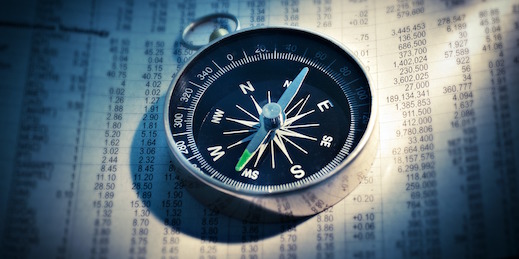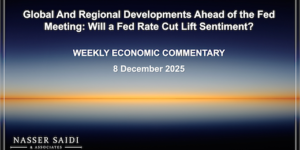Markets
Equity markets in the US finished last week in the red after stronger data releases, geopolitical tensions (related to Iran) and a Fed warning about reading too much into dovish comments from a policymaker; markets are still pricing in a 25-50bps cut. Political turmoil in Italy weighed on European shares, while in Asia the MSCI ex-Japan index climbed a modest 1% last week. Among regional markets, the UAE outperformed its peers, boosted by strong earnings reports from banks. The euro weakened on expectations of a rate cut (60% chance of a 10bps cut), and the sterling sank to its lowest in 27 months on elections/ Brexit. Oil prices fell last week, with the US crude recording the largest drop in almost two months and gold price was up for the week though it slipped from a fresh 6-year high on profit taking.
Global Developments
US/Americas:
- US retail sales grew by 0.4% mom in Jun (May: 0.4%), supported by strong auto sales (+0.7%), building material sales (0.5% from May’s -1.5%) and cheaper gas (-2.8%). Core retail sales (i.e. excluding automobiles, gasoline, building materials and food services) edged up 0.7% from 0.6% the month before.
- US industrial production remained unchanged in Jun though manufacturing output increasedby 0.4% mom in Jun (May: 0.2%), thanks to the 3% surge at auto plants. Capacity utilization fell in Jun to 77.9% from 78.1% in May.
- Housing starts fell by 0.9% to a seasonally adjusted annual rate of 1.253mn units in Jun (May: 1.265mn), with single-family homebuilding (which accounts for the largest share of the housing market) increased 3.5% to a rate of 847k units in June. Building permits dropped to a 2-year low, tumbling by 6.1% to 1.22mn units. Both indicators suggesting emerging weakness in the housing market.
- Initial jobless claims inched up by 8k to 216k in mid-Jul, with the four-week moving average declining by 250 to 218,750.
Europe:
- German ZEW economic sentiment fell 3.4 points to -24.5 points in Jul – the lowest reading since Oct 2018 – and compares to the long-term average of 21.8 points. The assessment of the economic situation worsened by 8.9 points to -1.1 points.
- The EU ZEW economic sentiment indicator fell 0.1 points from a month ago to -20.3 points in Jul while the indicator for the current economic situation fell by 6.9 to -10.6 points.
- Inflation in the euro area was finalized at 1.3% yoy in Jun, revised up from the previous estimate of 1.2%, and up from May’s 1.2%. Annual inflation in the EU was 1.6% in Jun, stable compared to May, and down from 2.1% a year ago.
- Eurozone trade surplus widened to EUR 23bn in May, thanks to a 7.1% yoy growth in exports and import growth of 4.2%. The EU’s surplus with the US widened by 12.1% yoy to EUR 62.1bn in Jan-May while with China the deficit expanded to EUR 76.7bn (10.8%).
- UK wages are catching up, growing at the fastest rate in 11 years: annual average earnings grew by 3.6% in Mar-May while the jobless rate remained at 3.8% – its lowest level since the mid-1970s.
- UK inflation remained unchanged at 2% yoy in Jun, while the PPI eased to 1.6% yoy in Jun (May: 1.9%).
- UK retail sales rose unexpectedly in Jun growing by 3.8% yoy, aided by sales of antiques and second-hand clothes; however, it grew by just 0.7% in Apr-Jun.
Asia Pacific:
- China GDP growth slumped to the lowest in 27 years, with Q2 GDP slowing to 6.2% (Q1: 6.4% and 2018: 6.6%). The service sector, which accounted for 54.9% of the total GDP, rose 7% in H1. China’s exports fell 1.3% yoy in dollar terms in H1, while imports dropped 7.3%.
- China retail sales expanded by 9.8% yoy to CNY 3.39trn in June, boosted by car sales (+17.2% yoy). China’s industrial production increased by 6.3% yoy in Jun, picking up from May’s 17-year low. Fixed asset investments in H1 grew by 5.8% yoy, with private sector investment in fixed assets up 5.7% in H1 (Jan-May: 5.3%).
- Japan’s exports fell for the 7th consecutive month in Jun, falling 6.7% yoy, dragged down by slowing sales of tankers, China-bound car parts and steel pipes. Asia-bound shipments, which account for more than half of Japan’s overall exports, declined 8.2% in the year to June. Imports fell by 5.2%, thereby logging in an overall trade surplus of JPY 589.5bn in H1.
- The Reuters Tankan survey showed Japanese manufacturers’ business confidence hit a three-year low in Jul. The sentiment index worsened to 3 in Jul (Jun: 6), dragged down by industries such as textiles/paper, steel/nonferrous metals and precision machinery.
- Japan’s inflation came in at 0.7% yoy in Jun, unchanged from the previous month; core inflation, at 0.6% yoy, was its weakest since Jul 2017 – largely due to the sharp slowdown in energy prices.
Bottom line:Geopolitical tensions are on the rise with the seizing of British vessels in the Strait of Hormuz, resulting in statements about “serious consequences”. Meanwhile, the IIF reported an increase in global debt to USD 246.5 trillion in Q1 this year, almost 320% of global economic output. China’s debt, at over USD 40trn, topped 300% of GDP and accounts for some 15% of all global debt. This is surpassed by US’s record-high USD 69trn debt in Q1 (up USD 2.9trn compared to Q1 2018). Lower growth prospects, rising geopolitical tensions, and rising debt levels amidst more loose monetary policy seems like a perfect ‘economic’ storm is brewing. To look forward to this week are also the new British PM, the ECB meeting on Jul 25 and initial PMI readings.
Regional Developments
- Bahrain-origin exports grew by 6% yoy to BHD 595mn (USD 1.56bn) in Q2 this year. Saudi Arabia (BHD 145mn), US (BHD 84mn) and UAE (BHD 65mn) were the top three importing nations. Value of imports declined by 11% to BHD 1.266bn.
- Over 7400 commercial registrations (CRs) were issued in Bahrain in H1 this year; this brings the total CRs to 82,878 of which 46,311 (or 55.9%) are Bahrainis.
- Egypt’s GDP grew by 5.6% yoy in the fiscal year 2018-19, according to the PM. He also disclosed a primary budget surplus of EGP 104bn (or 2% of GDP) and a narrowing of budget deficit to 8.2% of GDP (from the previous year’s 9.8% and below the official forecast of 8.4%). Separately, the World Bank forecasts GDP to grow by 6% in the fiscal year 2021 supported by “enhanced domestic demand and exports growth”.
- Egypt’s revenues from taxes on foreign trade increased by 16.7% yoy to EGP 35.516bn during Jul 2018-May 2019. VAT revenues grew by 19.66% yoy to EGP 310.03bn during the 11 months. Overall tax revenues grew by 18.1% to EGP 613.38bn and tax revenues accounted for 80.2% of total revenues.
- The IMF is set to vote on the final tranche of the USD 12bn loan to Egypt on Jul 24, according to the PM.
- Credit disbursed by banks in Egypt increased to EGP 1.8723trn in Jul 2018-Apr 2019, according to the central bank. Industrial sector accounted for bulk of the loans (33.6%) followed by services sector (27.3%) while miscellaneous sectors (including households) accounted for 26.9%.
- Egypt’s local liquidity grew by 11.65% yoy to EGP 3.797trn at end-May. Foreign holdings of Egypt’s treasury bills increased by 4.08% mom to EGP 276.46bn in May. The outstanding balances of T-bills rose by 2.2% mom to EGP 1.39trn at end-May. Total foreign currency deposits at Egypt’s banks declined by 3.2% mom to EGP 717.657bn (USD 43.17bn). In yoy terms, foreign currency deposits edged up by 0.18%.
- The Suez Canal Economic Zone plans to invest USD 55bn in 15 years, according to the Chairman of the authority. The value of projects being established in the Suez Canal Economic Zone has already reached USD 20bn.
- Egypt’s government has allocated EGP 34mn towards flood protection projects in the Red Sea governorate. Four rain harvesting dams have already been built at an estimated cost of EGP 34mn.
- Iraq’s oil exports from its southern ports reached 3.42mn barrels per day till mid-Jul; this compares to exports to the tune of 3.39mn bpd in Jun and 3.41mn bpd the month before.
- Inflation in Jordan picked up to 0.5% yoy in H1 this year, thanks to a rise in prices of beans and vegetables (0.37%), as well as rent and education costs
- Jordan’s tourism revenues increased by 8.3% yoy to USD 2.6bn in H1 this year, driven by a 5.6% uptick in the number of tourists.
- The Jordanian government is working with Parliament on an amendment which will give start-ups a five-year exemption from social security registration.
- Kuwait’s real GDP growth reached 2.6% yoy in Q1, with the oil sector growing at 1.3% and a non-oil sector expansion at 4.1%.
- The central bank of Kuwait issued bonds and related Islamic tawarruq worth KWD 240mn (USD 791mn), with a 3% rate of return; this issue was oversubscribed 10.89 times.
- Kuwait’s foreign reserves grew by 1.61% yoy and 0.42% mom to USD 39.37bn in May.
- Japan-Kuwait bilateral trade surplus narrowed by 29.8% yoy to USD 313mn in Jun, as Kuwait’s exports to Japan fell 26.6% to USD 425mn and imports also dropped by 9.6%.
- Lebanon’s lawmakers ratified an austerity 2019 budget on Friday, with 83 MPs voting in favour of endorsing the budget aiming for a cut in the budget deficit to about 7% down from 11.1% in 2018.
- Fiscal deficit in Lebanon narrowed by 28% yoy to USD 1.38bn in Jan-Apr 2019, thanks to a 15.4% decline in expenditures during the period, likely due to non-payment of dues and payables. On the revenues side, tax receipts fell by 3.3% yoy to USD 2.73bn during the period: 29.4% were VAT receipts that decreased by 17% annually.
- Lebanon’s gross public debt edged up by 0.3% yoy to USD 85.4bn in Jan-May 2019. Commercial banks held 38.2% of the public debt at end-May 2019 relative to 41.1% of the total at end-May 2018.
- Three ex-PMs of Lebanon, after their meeting with the Saudi King, indicated that Saudi Arabia planned to support Lebanon; this news lifted Lebanon’s dollar bonds.
- Oman’s nominal GDP grew by 12% yoy in 2018, according to the central bank, supported by a 37.1% and 2.9% rise in the oil and non-oil sectors respectively.
- Oman’s capital market raised OMR 1.8bn (USD 4.67bn) funds in 2018, according to the Capital Market Authority. The total value of the issued corporate bonds and Sukuk was OMR 277.4mn last year.
- Over 65k expatriates have left Oman between May 2018 and May 2019: the number of expats declined to 2.02mn by end-May 2019 and the expat workforce declined to 1.79mn.
- Businesses in Saudi Arabia will be given the option to remain open 24 hours a day (for a fee). The decision of whether or not to open all hours will be at the discretion of the individual business owners.
- Saudi Arabia approved a new Government Tendering and Procurement law which “seeks to allocate and manage financial resources effectively, provides more transparency in all tenders and procurement procedures”. SMEs will be exempt from providing initial guarantees and will also be given priority over larger competitors.
- Saudi Arabia is studying regulations to license new stock market operators, reported the Maaal financial website.
- Saudi crude oil exports dropped to 6.94mn barrels per day (bpd) in May (Apr: 7.18mn bpd).
- Saudi Arabia’s holdings of US treasuries ticked up by 10.36% yoy and 1.36% mom to USD 179bn in May. This is the 4th consecutive month of Saudi raising its treasuries holdings.
- The number of Saudis registered in the distance, off-site, work program increased by 64.58% yoy to 5469 last year, reported Al-Eqtisadiah. About 98% of these are women.
- Funding in MENA startups surged by 66% to USD 471mn in H1 this year, according to Magnitt. The UAE remained the most active ecosystem accounting for 26% of all deals, followed by Egypt (21%) and Lebanon (13%).
UAE Focus
- Inflation in Dubai fell to a 7-month low of 2.68% yoy in Jun, as housing and utilities costs fell by 6.4% as did transport (-0.99%) and healthcare (-0.3%).
- UAE changes sponsorship rules: the new resolution allows expats to bring family members into the country so long as the total monthly family income is AED 3000 (including housing) or AED 4000 (excluding housing), moving away from the job title criteria.
- Exports through Abu Dhabi ports increased by 14.8% yoy to AED 27.6bn (USD 7.5bn) in Q1 while the value of imports declined by 7.7% to AED 24.2bn. Saudi Arabia was the top export destination (AED 295.4mn) while Italy was the top import source (AED 19.2mn).
- Abu Dhabi’s Industrial Production Index expanded by 16.6% yoy to 142.5 in Q1, supported by the 16.3% increase in the “manufacture of unclassified machinery & equipment”.
- The Abu Dhabi Global Markets issued new Fintech regulations: a regulatory framework for digital investment managers, or robo-advisers, was published last week with requirements including human oversight over the design, performance and security of the algorithm model as well as at least USD 250k base capital needed to manage assets. The ADGM also published a guide on the establishment of digital banks earlier this month.
- Nasdaq Dubai listed a USD 1bn Sukuk and a USD 300mn conventional bond from DP World last week. DP World is the largest UAE debt issuer by value on the exchange, with sukuk and conventional bond listings now totaling USD 8.09bn.
- Over 2055 SMEs received support from the government agency Dubai SME in H1 this year – an increase of 83% compared to last year; the value of incentives and exemptions provided expanded by 86% yoy to over USD 10mn this year.
- A UAE citizen should be paid a minimum wage of AED 5000 (USD 1361) in private sector jobs, reported Emarat Al Youm, citing the Ministry of Human Resources and Emiratisation.
- The ruler of Sharjah disclosed that the emirate’s government would recruit 1,000 Emiratis this year.
- The Sharjah Real Estate Registration Directorate reported over AED 14.7bn (USD 3.9bn) worth of real estate transactions in the emirate in H1 2019. GCC nationals’ real estate investments in Sharjah exceeded AED11.8bn, while other nationalities invested over AED2.8bn.
- Real estate prices dip: average house price in Dubai has fallen to AED 2.46mn (USD 670k) in Jun (falling by USD 10k on average since Apr) according to Property Monitor research. In Abu Dhabi, residential property prices are 13% yoy lower according to ValuStrat which also revealed that residential rents were also lower by 2% qoq and 7.9% yoy in Q2 this year.
- The UAE is gearing up to issue a new space law, which will promote investment in the space sector, including space tourism and exploration, according to the director General of the UAE Space Agency. He disclosed that about 1500 persons work in the sector with over half of them young Emiratis.
- The region’s largest airport solar energy system: 15,000 photovoltaic panels have been installed at Dubai International’s Terminal 2 which will generate 7,483,500 kWh energy annually for Dubai Airports resulting in savings of AED 3.3mn.
Media Review
The slope of the US yield curve and risks to growth
https://blogs.imf.org/2019/07/02/the-slope-of-the-us-yield-curve-and-risks-to-growth/
Are Central Banks Losing Their Big Bet?
https://www.project-syndicate.org/commentary/central-banks-unconventional-policy-bet-by-mohamed-a-el-erian-2019-07
What’s Really Behind China’s Falling GDP?
https://knowledge.wharton.upenn.edu/article/chinas-gdp-falling/
Why central banks need to step up on global warming
https://foreignpolicy.com/2019/07/20/why-central-banks-need-to-step-up-on-global-warming/
Trouble in the Persian Gulf
https://www.economist.com/middle-east-and-africa/2019/07/19/iran-seizes-a-british-oil-tanker
Powered by:









